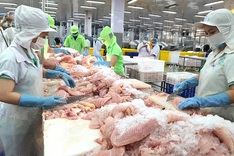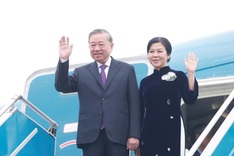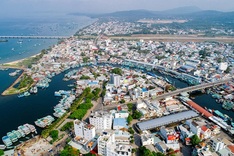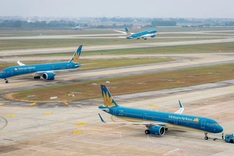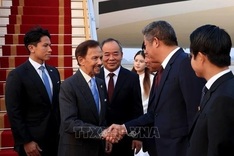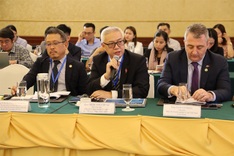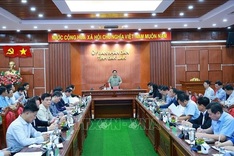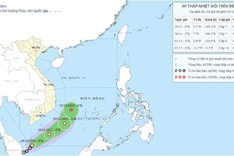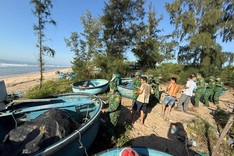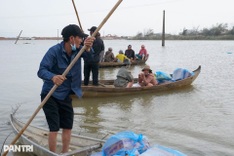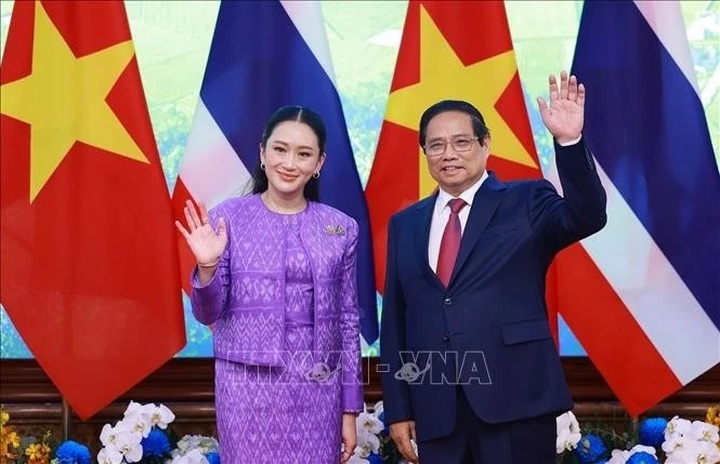
Vietnamese Prime Minister Pham Minh Chinh (right) and Thai Prime Minister Paetongtarn Shinawatra in Hanoi on May 16. (Photo: VNA)
Following is the full text of the joint statement.
JOINT STATEMENT
ON THE ELEVATION TO A COMPREHENSIVE STRATEGIC PARTNERSHIP BETWEEN VIET NAM AND THAILAND
--------
1. Since the establishment of diplomatic relations in 1976, Viet Nam and Thailand have built a strong and broad relationship based on mutual trust and understanding. The Viet Nam – Thailand Strategic Partnership, announced in 2013, has supported the deepening of ties across all areas of the bilateral relationship and brought practical benefits to the two countries and their peoples.
2. The shared benefits, aspiration for peace, independence, self-reliance, as well as a common vision of security, prosperity, sustainable development, compliance with international law, including the United Nations Charter, serve as a solid foundation for the continued development of the relationship between the two countries.
3. To further elevate bilateral relations between Thailand and Viet Nam to new heights, H.E. Mr. Pham Minh Chinh, Prime Minister of the Socialist Republic of Viet Nam, and H.E. Ms. Paetongtarn Shinawatra, Prime Minister of the Kingdom of Thailand, jointly announced the elevation of the bilateral relationship toa Comprehensive Strategic Partnership on the occasion of the 4th Viet Nam - Thailand Joint Cabinet Retreat, during the official visit to Viet Nam of H.E. Ms. Paetongtarn Shinawatra from 15 to 16 May 2025. This milestone reflects the shared ambition of the two countries for a comprehensive relationship and deeper cooperation.
4. In declaring the Comprehensive Strategic Partnership, the two countries commit to consolidating and further strengthening all aspects of their relationship while respecting international law and each other’s independence, sovereignty, territorial integrity, mutual interest and respective political systems.
5. In this regard, the two Governments agreed to usher in a new chapter of a the Comprehensive Strategic Partnership for peace, stability and mutual prosperity through three substantive pillars: (1) Partnership for Sustainable Peace,
(2) Partnership for Sustainable Growth, and (3) Partnership for Sustainable Future.
PARTNERSHIP FOR SUSTAINABLE PEACE
Deepening political, defense and security cooperation
6. Both sides agreed to further strengthen mutual trust through exchanges of visits and cooperation via all channels, including State, Government, Party, National Assembly, people-to-people, provincial and local channels, as well as the private sector. This includes annual meetings between the two Prime Ministers in Viet Nam, Thailand or on the sidelines of multilateral high-level meetings.
7. Both sides agreed to develop the Plan of Action on Implementing the Viet Nam - Thailand Comprehensive Strategic Partnership 2025 – 2030, in line with new developments and based on the Plan of Action on Implementing the Viet Nam - Thailand Strengthened Strategic Partnership 2022 - 2027. They also committed to effectively implementing the Memorandum of Cooperation between the National Assembly of Viet Nam and the House of Representatives of Thailand, signed in December 2023, to establish a legal foundation for promoting bilateral cooperation. They also agreed to continue effectively implementing bilateral cooperation mechanisms such as Joint Cabinet Retreat, Joint Commission on Bilateral Cooperation, Defense Policy Dialogue, High-Level Dialogue on Crime Prevention and Security Issues, Joint Working Group on Political and Security Cooperation, and Political Consultation Group.
8. Both sides agreed to strengthen cooperation between their Defence Ministries and Military Forces including navy, airforce, coast guard through activities such as joint patrols, sharing thematic experiences, education and training, intelligence information sharing, and officer exchanges. They also agreed to explore new areas of cooperation, such as defence industry, military medicine, search and rescue, and law enforcement at sea.
9. Both sides reaffirmed their commitment not to allow any individual or organization to use the territory of one country to conduct activities against the other. They agreed to further enhance security cooperation; and to work together in preventing and combating transnational crimes, including drugs trafficking, irregular migration, human trafficking, human smuggling, arms smuggling, terrorism, money laundering, international economic crime, high-tech crimes, and environmental crime. They also agreed to work closely in addressing illegal, unreported, and unregulated (IUU) fishing matters.
10. Both sides agreed to enhance legislative and judicial cooperation and committed to effectively implementing signed agreements between the two countries on preventing and combating crime, transferring sentenced persons and cooperating in the enforcement of penal sentences. They also agreed to continue working closely on the negotiation of the Extradition Treaty and the Treaty on Mutual Legal Assistance in Criminal Matters and to consider looking into amending and supplementing the 2008 Agreement on Bilateral Cooperation in Eliminating Trafficking in Persons, Especially Women and Children, and Assisting Victims of Trafficking. They pledged to effectively implement the 2015 Memorandum of Understanding on Cooperation between the Ministry of Justice of Viet Nam and the Ministry of Justice of Thailand; to futher strengthen mutual support and assistance in multilateral legal and judicial forums; and to explore new appropriate agreements to create a favorable legal corridor for cooperation between law enforcement agencies in combating crime.
Promoting multilateral, regional and international cooperation
11. Both sides agreed to promote cooperative relations between the two countries in regional and international fora, including the United Nations (UN), World Trade Organization (WTO), Asia-Pacific Economic Cooperation (APEC), Asia-Europe Meeting (ASEM) as well as within parliamentarian frameworks, especially on general issues of peace and security, international peacekeeping, humanitarian relief, sustainable development, and responses to global challenges.
12. Both sides agreed to maintain close cooperation and consultation within ASEAN and ASEAN-led mechanisms. They pledged to promote ASEAN’s unity, centrality and efforts to further advance the ASEAN Community building process, including the development and realization of the ASEAN Community Vision 2045 and its Strategic Plans.
They also committed to enhancing cooperation in areas that are drivers of economic growth and sustainable development, such as digital transformation, energy transition, green economy, circular economy, etc., as well as addressing emerging regional and international challenges. Both sides stressed the importance of strengthening ASEAN’s role in sub-regional development, especially the Mekong sub-region.
13. Both sides affirmed their commitment to further collaborate and coordinate within various Mekong-centered sub-regional cooperation mechanisms, including Ayeyawady – Chao Phraya – Mekong Economic Cooperation Strategy (ACMECS), Mekong River Commission (MRC), the Greater Mekong Subregion (GMS), and other Mekong-related cooperation frameworks for a resilient and sustainable Mekong sub-region. They agreed to promote synergies, complementarity, and alignment between sub-regional cooperation frameworks and the ASEAN Community building process, contributing to narrowing the development gap and fostering the comprehensive development of ASEAN. Both sides also committed to addressing transboundary challenges, including but not limited to effective and sustainable water management, security and utilization, climate change, haze pollution, and food security. They agreed to explore the possibilities of trilateral development cooperation with other countries in the Mekong sub-region in areas that will be mutually beneficial.
14. Both sides agreed to work together and with other countries, within and outside the region, to promote peace, stability, security, safety, and freedom of navigation in and overflight above all maritime sphere of Southeast Asia, particularly the South China Sea and in this regard, reiterated ASEAN’s consistent position on the South China Sea. They reaffirmed the importance of and called for exercise of self-restraint in the conduct of activities that would further complicate or escalate disputes and undermine peace and stability. Both sides emphasized the avoidance of actions that may further complicate the situation and called for the settlement of disputes by peaceful means, without resorting to the threat or use of force, in accordance with international law, especially the 1982 United Nations Convention on the Law of the Sea (UNCLOS), with full respect for legal and diplomatic processes. They reaffirmed that the 1982 UNCLOS sets out the legal framework within which all activities in the oceans and seas must be carried out. They reaffirmed their support for the full and effective implementation of the Declaration on the Conduct of Parties in the South China Sea (DOC) in its entirety, while fostering a conducive environment for and working towards the early conclusion of an effective and substantive Code of Conduct in the South China Sea (COC) that is in accordance with international law, especially the 1982 UNCLOS.
PARTNERSHIP FOR SUSTAINABLE GROWTH
Strengthening economic cooperation
15. Both sides agreed to promote close cooperation mechanisms between Government and Government, associations and associations, provinces and provinces, and businesses and businesses to strengthen trade and investment flows. They pledged to promote the connection between the two economies through cooperation and complement each other’s strengths, in the spirit of "mutually beneficial and mutually developed cooperation".
16. Both sides recognized each other's role as leading trading partners and committed to enhancing trade cooperation to reduce trade and investment obstacles towards more balanced and mutually beneficial trade between the two countries. They strive to achieve the bilateral trade target of USD 25 billion, as agreed by the Leaders of the two countries, and to establish a new target for the next period. In the field of trade remedies, both sides committed to conducting investigations based on the principles of objectivity, transparency, and fairness, in accordance with national laws and the World Trade Organization (WTO) commitments. They also agreed to promote cooperation and information exchange on issues of mutual concern between the two countries.
17. Both sides encouraged businesses in each country to expand investment and engage in long-term operation in the other country’s market. They committed to cooperating and supporting each other to participate more deeply in the value chain and fostering sustainable business practices. They aimed to create a business-friendly environment to mitigate the impacts of current global trade tensions.
18. Both sides agreed to enhance cooperation on labour, employment and social security issues, including the early signing of a new Memorandum of Understanding on Labour Cooperation between Viet Nam and Thailand and the Agreement on the Employment of Vietnamese workers in the Kingdom of Thailand.
19. Both sides encourage close coordination and collaboration between relevant agencies of the two countries, particularly in areas of transportation, customs, finance and banking, to further facilitate trade, transportation and transit of goods between the two countries and to third countries, especially at border checkpoints. They agreed to share experience and promote cooperation between the two central banks, particularly in the areas of cross-border payment, banking inspection and supervision, and financial innovation.
20. Both sides agreed to effectively leverage the economic frameworks and free trade agreements to which both sides are members, including ASEAN Trade in Goods Agreement (ATIGA) and other free trade agreements between ASEAN and its partners, such as the Regional Comprehensive Economic Partnership (RCEP). They committed to working together to implement the ASEAN Outlook on the Indo – Pacific and the APEC Putrajaya Vision 2040 to bring practical benefits to localities, businesses and people.
Effectively implementing the "Three Connects" Strategy to bolster socio-economic development of both countries
21. With the establishment of a Joint Working Group, both sides agreed to capitalize on the shifting trends of global production and supply chains to strengthen the connection between the two countries’ supply chains, especially in complementary and mutually beneficial areas, such as agriculture, petrochemical, machinery, electronic parts, and logistics. They also aim to form new supply chains in areas where both sides have potential and strengths.
22. Both sides agreed to connect their local and grassroots economies, particularly between localities and Micro, Small, and Medium Enterprises (MSMEs), as well as start-ups, with a view to promoting more cross-border economic activities. They also agreed to explore measures to facilitate market access for each other’s local products, including mutual recognition arrangements for products under Thailand’s One Tambon One Product (OTOP) and Viet Nam’s One Commune One Product (OCOP) programmes. Both sides committed to enhancing connectivity through multi-modal transport and logistics linkages between the two countries and within the sub-region. They also agreed to enhance local-to-local cooperation to stimulate cross-border economic activities along the East - West Economic Corridor and the Southern Economic Corridor.
23. Both sides will explore potential collaboration to effectively align the green and sustainable growth strategies of the two countries, particularly by connecting Viet Nam’s National Green Growth Strategy 2021 – 2030 with a vision to 2050 and Thailand’s sustainable development strategy to guide the two economies towards a common platform of cooperation, covering potential areas such as the green economy, digital economy, digital transformation, fair energy transitions, climate-smart agriculture, eco-tourism, and response to challenges of climate change. Both sides will share experience to develop a cooperative model that promotes green transformation, towards achieving a low-carbon economy and eventually net-zero carbon emission.
PARTNERSHIP FOR SUSTAINABLE FUTURE
Promoting cooperation in science, technology and innovation
24. Both sides agreed to promote cooperation in science, technology and innovation, including the sharing of information and experience in developing innovation ecosystems and connecting the innovative startup networks between the two countries, as well as paving the way for further utilisation and commercialisation.
25. Both sides committed to enhancing cooperation in the digital economy, focusing on potential areas, such as cross-border transactions, e-commerce, and digital finance services, which will further facilitate trade, investment, tourism and financial integration between the two countries and within the region.
26. Both sides agreed to promote cooperation and the sharing of knowledge and experiences in the formulation of policies, legal documents, development and management strategies in thematic areas such as artificial intelligence (AI), digital transformation, digital government, digital economy, cyber security and smart cities.
Promoting deeper mutual understanding and closer friendship between the peoples of the two countries
27. Both sides committed to jointly conducting activities to celebrate the milestone years of the two countries, including the 50th anniversary of diplomatic relations between Viet Nam and Thailand in 2026.
28. Both sides agreed to promote people-to-people exchanges, especially more frequent exchanges among youths, through activities in the fields of education, culture, entrepreneurship, language and environment, to foster mutual understanding, closer friendship and a stronger sense of shared future cooperation between peoples, youths and the two countries.
29. Both sides agreed to further strengthen cooperation in education and training; to continue to promote and expand Thai and Vietnamese language teaching in each country; to encourage the opening of language, culture and education centers of one country in the other; and to promote faculty and student exchanges between schools and universities of the two countries.
30. Both sides agreed to work closely with other countries involved to advance the implementation of Thailand’s proposal on intra-regional connectivity, with an aim to facilitate seamless travel and to attract more tourists from outside the region under the initiative “Six Countries, One Destination”. They also agreed to encourage the opening of new direct flights between provinces of the two countries to promote tourism in both countries, foster people-to-people exchanges and enhance connectivity in the Mekong sub-region.
31. Both sides agreed to work together in preserving cultural values and promoting cultural exchanges, including upholding cultural sites such as President Ho Chi Minh historical sites, Vietnamese temples, and Viet Nam Town as symbols of friendship and cooperation between the two countries. They also agreed to support exchanges of the Annam Nikai’s delegations between the two countries.
32. Both sides support close cooperation between relevant authorities of the two countries, including the Thailand International Cooperation Agency (TICA) of the Ministry of Foreign Affairs of Thailand and the Ministry of Planning and Investment of Viet Nam, towards achieving the Sustainable Development Goals (SDGs) and expanding Thailand’s development cooperation projects in Viet Nam. These projects include theProject on Sustainable Community Development based on the Application of the Sufficiency Economy Philosophy (SEP) in Thai Nguyen and Ben Tre provinces, the Project on Development of Thai Language and Thai Studies, and the deployment of 5 Thai volunteers working as Thai teaching assistants in 4 universities in Viet Nam under the Friend from Thailand Programme.
33. Both sides agreed to fully utilise sister city frameworks between provinces of both countries, including promoting regular exchanges, organizing forums and conferences for direct cooperation between provinces in a concrete and sustainable manner, with a view to promoting local strengths and products as well as fostering broader and deeper exchanges at the local-to-local level.
34. Both sides committed to creating favourable conditions for the living, working and studying of Vietnamese citizens in Thailand and Thai citizens in Viet Nam. They also pledged to support the active roles of the Vietnamese community in Thailand and Thailand community in Viet Nam in cultivating solidarity and people-to-people ties between the two countries. Both sides agreed to continue to promote the roles and contributions of the Viet Nam – Thailand Friendship Association, Thailand – Viet Nam Friendship Association, Viet Nam - Thailand Parliamentarian Friendship Groups, and other Thai - Vietnamese associations to strengthen mutual understanding, friendship and cooperation between the two peoples.
Concluded on 16 May 2025 in duplicate in English, each being equally valid.





